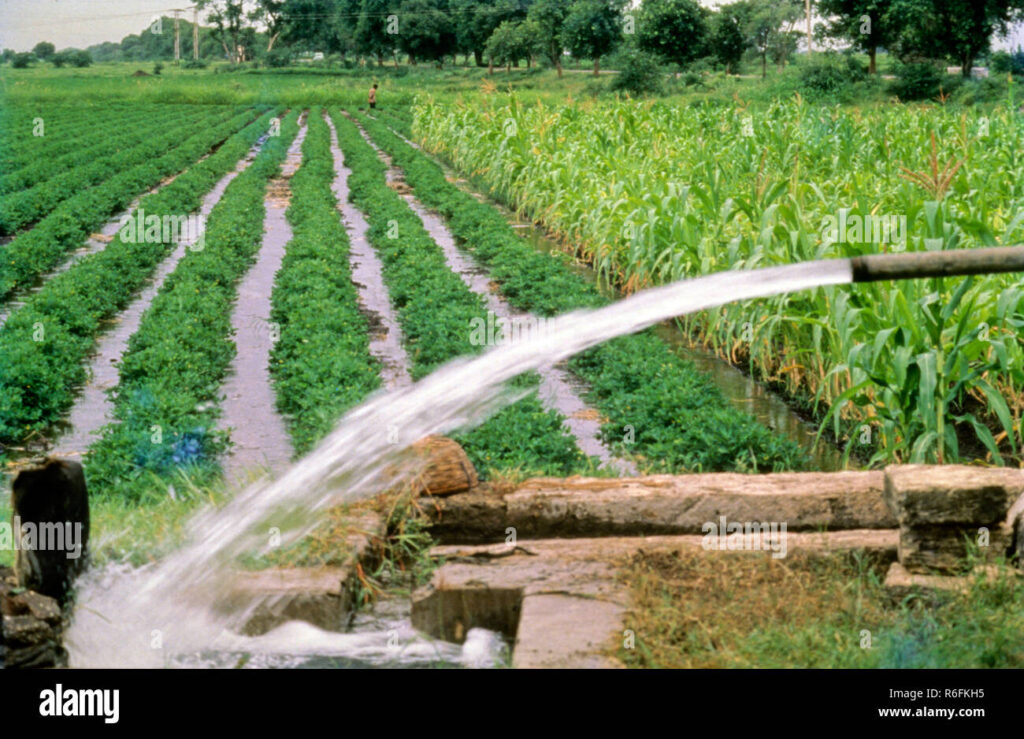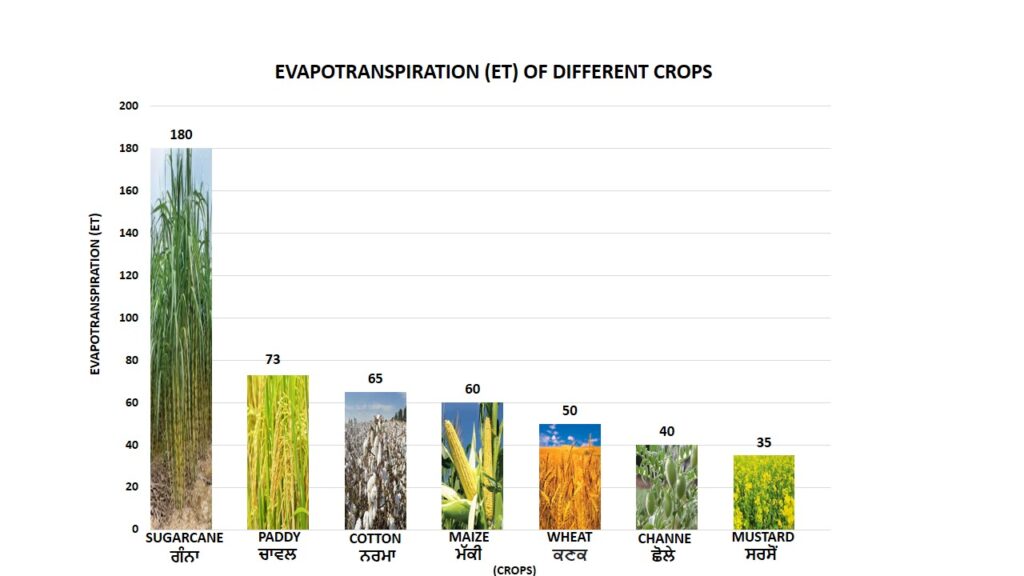Punjab farmers are facing a lot of criticism from every quarter be it an average citizen, scientist, or a planner for depleting underground water in the state. As per Govt. Statistics the water table in the state is going down by 30 to 100 cm every year. Most of the blocks in Punjab are either in black or grey zones. Even the farmers are paying hefty amounts to get their bore wells deep to extract water. I may add here that this cost is not accounted for at the time of calculating the cost of cultivation of farm produce. The cultivation of paddy is considered the sole culprit for depleting the water table but if we analyze the data-intensive cultivation is the main factor. It means getting more than two crops in a year. As per Agriculture and revenue department data, 42 lakh hectare area is cultivable, whereas the cropped area is 77 lakhs 39 thousand hectares meaning thereby a cropping intensity of 186% giving an impression that even two crops per year are not raised in the whole cultivable area of the state. This figure of cropping intensity raises doubts when we examine the irrigation intensity (>98%). The source of irrigation (73% by tube wells) and more than 86% of farmers are small farmers. Almost the whole Punjab is taking two crops a year. Of course, there are a few crops like sugarcane which has a cultivated area of 92000 hectares, fruits 84500, similarly vegetables 264000 hectares and fodder is 568000 hectares. This whole area is under cultivation for full-year which means irrigation is required throughout the year. On the other hand, in traditional cropping patterns either of wheat paddy or maize-wheat the land remains vacant for almost 3-4 months. Gives a clear indication that the cropping intensity is around 230% to 240% rather than 186% and the requirement for watering crops needs to be counted on this basis.

Water requirement for different crops: The water is used by plants for metabolism and transpiration of course when you irrigate the fields some water will be lost as evaporation. Thus, the water consumption by crops is measured as evapotranspiration (ET). How much water is used by each crop depends on crop type, yield, and season in which it is grown. Thus, every crop has different evapotranspiration (ET). The ET for paddy is 73 cm, sugarcane 180cm, cotton 65cm, maize 60 cm, groundnut 50 cm, wheat 50 cm, grams 40 cm, and mustard (sarsoan) 35 cm. To cultivate paddy 120-180cm of water is required for irrigation but actually, 73 cm is used by the crop and the rest goes back to the ground through leaching. Giving clear indication that it was just 8 cm extra water from cotton and 13 cm from maize. Of course, the cost of using electricity to pump the water increases but the water is not wasted to the extent it is believed. Here we need to understand that if we advocate maize, the price and yield of maize are not as remunerative as of paddy. So, farmers will try to get the third crop of fodder or 60 days moong in a gap between wheat and maize to fill the income gap. The third crop will be grown in peak summers from (20th April to 30th June) which will need another 45 to 50 cm of water.

It is also assumed that farmers are cultivating paddy due to free electricity. It may be mentioned here that when paddy was adopted on a large scale the no. of tube wells was less and the irrigation was supplemented with diesel pumping sets. The electricity for agriculture was not free and the farmers were happily paying Rs. 50/- per H.P which could have been easily increased with the increasing price of the crop, but due to vote bank politics it was made free. But the change in cropping pattern (Maize/ Cotton to Paddy) was sheer economics. This started with a vicious circle of giving free units to certain categories of weaker sections and subsidizing electricity to industry. The whole situation never favored a farmer, the reason being domestic electricity bills were doubled to Rs 10 percent, and farmers are paying those year-round whereas pumping sets are operated for a limited period.
Water Budget: The rainfall in different parts of Punjab varies from 35 cm to 100 cm with an overall average of 65-70 cm annually. There are three prominent zones northern zone comprising districts of Pathankot, Gurdaspur, Hoshiarpur, Ropar, and Mohali with an annual rainfall of 80-100 cm. The central zone comprises Amritsar, Tarn-Tarn, Kapurthala, Jalandhar, Nawan-Shehar, Ludhiana, Fatehgarh Sahib, Malerkotla, Patiala, Moga, and Sangrur, etc. with an average rainfall of 65-70 cm. The southern districts of Ferozepur, Faridkot, Mukatsar, Bathinda, Mansa, etc. receive an annual rainfall of 35-40 cm. Thus the average annual rainfall in the state is 65 cm. On the other hand, the annual average evapotranspiration of the crops grown in the state is 125 cm. This information is reported by Ms. Harmanjot Kaur and associates of PAU, Ludhiana based on a study carried out between 2007-08 to 2012-13. The 125 cm split is 75 cm for Kharif crops and 50 cm for rabi crops. The above data show that rainwater can meet only half the ET requirement of crops which is then supplemented by a canal or tube-well water. Hydrologist A.K.vashist reported in 2016 that Punjab faces a water shortage of 1.27 mham. It has been estimated that the total rechargeable water in the state is 21.44 BCM (Billion Cubic meters) whereas the annual withdrawal is 31.16 BCM. Thus 9.72 BCM water is drawn from the underground reserves, which are not rechargeable and is the cause of the annual lowering of the water table from 30-100 cm.
River Water Distribution: At present three rivers flow through Punjab namely Sutlej, Beas, and Ravi, there were four in undivided Punjab. The water of the river Yamuna exclusively went to Haryana. Now coming on a share of waters from various rivers, approximately 1.11 million-acre water flows to Rajasthan through gang canal to reach Ganganagar district. Rajasthan also gets a 15.22% share from Bhakhra Mainline Canal (BML). The share of Haryana in BML is 49% and the remaining 35% is used in Punjab. At the time of the division of water Ravi and Beas, water was acknowledged as surplus which was estimated to be 15.22 MAF, out of which 8 MAF was allotted to Rajasthan and 7.22 MAF was given to undivided Punjab (Before 1966). After Haryana was carved out of Punjab 3.5 MAF was given to Haryana and 3.72 MAF was vested with Punjab out of 3.72 MAF was allotted to Delhi during the internal emergency years of 1975-77. While dividing irrigation water in 1966 the Yamuna water irrigating combined Punjab was not accounted for. As per Dr. Vashist’s report, the total water available for Punjab at that time (1966) was just 75% of the requirement.
Rajasthan Feeder or Indra Gandhi Canal: This canal was built along the Pakistan border 40-50 Km inside the borderline. The total length of the main canal is 650 Km designed to carry the 8 MAF Ravi- Beas water from Harike Barrage. The right side of the canal is irrigated by natural flow whereas the left side is irrigated with lift canals. Heavy-duty pumps are installed to lift the water from the main canal. The canal digging and construction was divided into two stages.
The stage-I canal is 394 Km long and its distributaries and minors are 3454 Km long. The stage-I canal was supposed to irrigate 0.553 million hectares of land. The irony was that the canal started in 1961 and within a span of 20 years (i.e., 1981) 9% of the command area was reeling from the problem of waterlogging. By 1990, 25% of the command area was in a danger zone, water table came up, 1 to 6 meters from ground level. In 1991 scientists estimated that by 2000, 50% of the area will face the water logging problem because, by that time (1991), 127 places around the canal were turned into ponds. This was the time when the government planned bio drainage. In this project, trees are planted and forests are developed along both sides of the canal. Even irrigation intensity was reduced to 80 from 100 means the water allowance given was also reduced. The whole story narrates that it did more damage than benefit.
The canal length in the Punjab area is 170 Km, although the canal was lined to avoid seepage even then it created water logging problems on both sides of the canal by the seventies. This was the main reason for the introduction of paddy hitherto known as the cotton belt. Even today some areas of the state suffer from water logging due to this reason.
The main canal length in stage-2 was 256 Km whereas the sub canal and distributaries’ length is about 5606 Km with a command area of 1.41 million hectares. Apprehending the phase-1 problems the water allowance of 2 cusecs per 1000 hectares was given which means that water was distributed thinly in more areas. The problem of this area was different which was related to wind flow velocity in the area. The wind flows at about 25 to 27 Km in summer and the dust storms of wind velocity range from 50 to 100 Km per hour in the peak summer. Central Arid Zone Research Institute (CAZRI) research says that sand dunes having 10 to 12 % vegetation doesn’t move with the wind and remain intact. The moment the sand dunes are disturbed for cultivation it moves from their place filling distributaries and canals with sand. As per the CAZRI report, about 1200 tons of sand/ hectare move forward from a field prepared for sowing with a tractor. The result is that when one tries to bring the additional area under cultivation the sand dunes move ahead to the flat area already under operation. Sand moves to the flat area already having vegetation leading to new sand dunes formation.


Conclusion: Water consumption cannot be reduced with existing genotypes without losing productivity and generating unemployment. The field situation is that places, where river water can be easily used for irrigation and its production efficiency, are maximum is not used over there. Punjab is spending 6600 crores on electricity to extract water from the ground. On the other hand, the same river water is taken a hundred Km away leading to different kinds of problems like waterlogging and shifting of sand dunes. There is a loss of water and money is spent to solve the problems.
Thus we need to understand that drinking water is necessary for every human being and that needs to be supplied through a pipeline indulging in minimum wastage of water. If oil and gas can be supplied through pipes why not water. Water which is put in 9700 Km Indra Gandhi Canal and its distributaries is being polluted, evaporated, and wasted through seepage. For the survival of local residents’ employment should be generated by generating other employment avenues and cheap ration should be supplied from other parts of the country. We are one nation and its natural resources need to be utilized efficiently not wasted to create problems due to political reasons. To rectify the current situation, it is necessary to reassess water availability from the four rivers Sutlej, Beas, Ravi, and the Yamuna because due to decreased rainfall the flow of water in rivers is less than estimated in the fifties. The command area of Punjab, Haryana, and Rajasthan need to be reassessed based on requirements and water usage efficiency, so that country’s valuable resources can be utilized effectively.
Dr Amanpreet Singh Brar